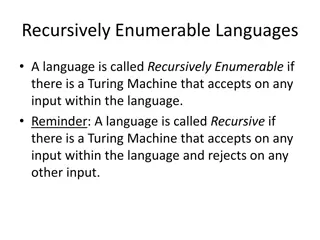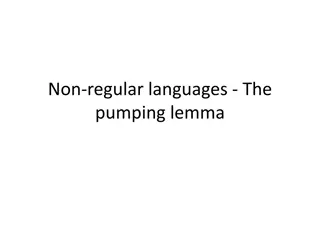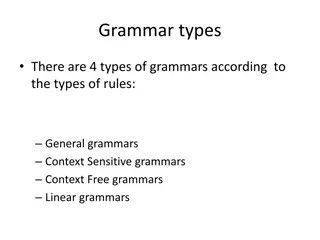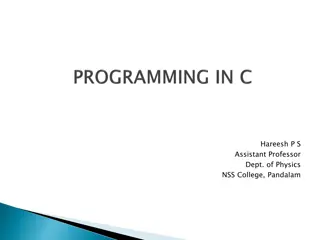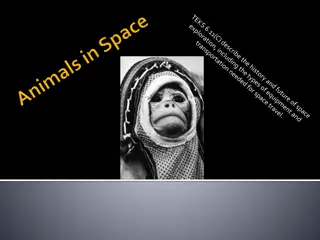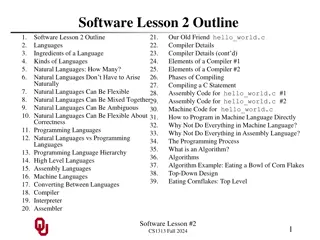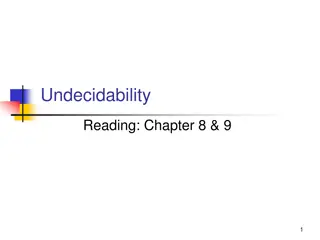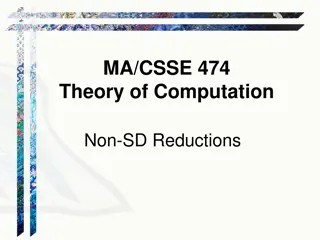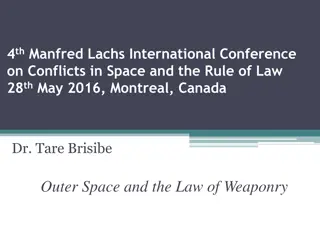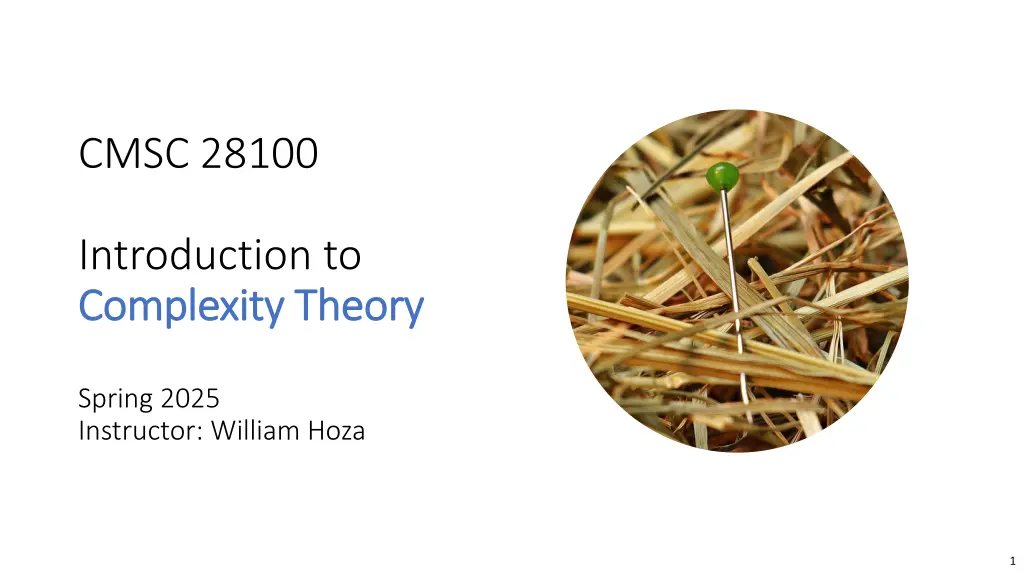
Understanding Complexity Theory and Turing Machines
Explore the principles of complexity theory, Turing machines, and their configurations through rigorous definitions and examples. Discover how problems are solved through computation using detailed explanations and visual aids.
Download Presentation

Please find below an Image/Link to download the presentation.
The content on the website is provided AS IS for your information and personal use only. It may not be sold, licensed, or shared on other websites without obtaining consent from the author. If you encounter any issues during the download, it is possible that the publisher has removed the file from their server.
You are allowed to download the files provided on this website for personal or commercial use, subject to the condition that they are used lawfully. All files are the property of their respective owners.
The content on the website is provided AS IS for your information and personal use only. It may not be sold, licensed, or shared on other websites without obtaining consent from the author.
E N D
Presentation Transcript
CMSC 28100 Introduction to Complexity Theory Complexity Theory Spring 2025 Instructor: William Hoza 1
Homework Exercises 1-4 are available in Canvas (due on Tuesday) If you aren t officially enrolled, send me an email Office hours (Thursday, Friday, Monday) are a good place to find study partners / homework collaborators 2
Which problems Which problems can be solved can be solved through computation? through computation? 3
Defining Turing machines rigorously Definition: A Turing machine is a 7-tuple ? = ?,?0,?accept,?reject, , ,? such that Warning: The definition in the ?is a finite set (the set of states ) textbook is slightly different. Sorry! (The two models are equivalent.) ?0,?accept,?reject ? and ?accept ?reject is a finite set of symbols (the tape alphabet ) is a symbol (the blank symbol ) 0,1, and 0,1 ? is a function ?:? ? {L,R}(the transition function ) 4
Configurations of a Turing machine Let ? = ?,?0,?accept,?reject, , ,? be a Turing machine A configuration is a triple (?,?,?) where ? , ? ?, ? , and ? ? Interpretation: The tape currently contains ?? The machine is currently in state ? and the head is pointing at the first symbol of ? ?1 ?2 ?? ?2 ?? ?1 ? 5
The initial configuration Let ? 0,1 be an input The initial configuration of ? on ? is ?0? ?0 if ? = ? if ? ? 6
The next configuration For any configuration ???, we define NEXT ??? as follows: Break ??? into individual symbols: ??? = ?1?2 ?? 1????1?2?3 ?? If ? ?,?1 = ? ,?,R , then NEXT ??? = ?1?2 ?? 1???? ?2?3 ?? Edge case: If ? = 1, then NEXT ??? = ?1?2 ?? 1???? If ? ?,?1 = ? ,?,L , then NEXT ??? = ?1?2 ?? 1? ????2?3 ?? Edge case: If ? = 0, then NEXT ??? = ? ? ?2?3 ?? We write NEXT???? if ? is not clear from context 7
Halting configurations An accepting configuration is a configuration of the form ??accept? A rejecting configuration is a configuration of the form ??reject? A halting configuration is an accepting or rejecting configuration 8
Computation history Let ? 0,1 be an input Let ?0 be the initial configuration of ? on ? Inductively, for each ? , let ??+1= NEXT ?? The computation history of ? on ? is the sequence ?0,?1, ,??, where ?? is the first halting configuration in the sequence If there is no such ??, then the computation history is ?0,?1,?2, (infinite) 9
Accepting, rejecting, and looping If the computation history of ? on ? ends with an accepting configuration, then we say that ? accepts ? If the computation history of ? on ? ends with a rejecting configuration, then we say that ? rejects ? In either of those cases, we say that ? halts on ?. If the computation history of ? on ? is infinite, then we say that ? loops on ? 10
Time Suppose the computation history of ? on ? is ?0,?1, ,?? We say that ? is the running time of ? on ? If ? loops on ?, then its running time on ? is We say that ? halts on ? within ? steps if the running time of ? on ? is at most ? 11
Space The space used by ? on ?is the number of cells that are used I.e., the head visits the cell OR the cell initially contains an input bit (Can be ) Which of the following statements is false? A: Space used on ? is at most B: If ? halts on ? within |?| steps, then ? halts on ?? Formally, let ?0,?1, be the (finite or infinite) computation history of ? on ? ? + 1 + running time on ? C: If ? halts on ?, then ? uses a finite amount of space on ? D: If ? uses a finite amount of space on ?, then ? halts on ? Write ??= ??,??,?? where ?? , ?? ?, ?? Respond at PollEv.com/whoza or text whoza to 22333 The space used by ? on ? is max ???? ? 12
Which problems Which problems can be solved can be solved through computation? through computation? 13
Languages A binary language is a set ? 0,1 Each language ? 0,1 represents a distinct computational problem: Given ? 0,1 , figure out whether ? ? 14
Deciding a language Let ? be a Turing machine and let ? 0,1 We say that ? decides ? if ? accepts every ? ?, and ? rejects every ? 0,1 ? This is a mathematical model of what it means to solve a problem 15
Example: Palindromes Informal problem statement: Given ? 0,1 , determine whether ? is the same forward and backward. The same problem, formulated as a language: PALINDROMES = ? 0,1 ? is the same forward and backward 16
Example: A TM that decides PALINDROMES 0,1 R L ?0 0 R ?reject ?0 0,1 L L ?1 1 ?accept 0,1 R 17
Example: Parity Informal problem statement: Given ? 0,1 , determine whether the number of ones in ? is even or odd. The same problem, formulated as a language: PARITY = ? 0,1 ? has an odd number of ones 18
Example: A TM that decides PARITY Let ? = ?,?0, 1, 0, , ,? , where ? = ?0,?1, 0, 1, = 0,1, , and ? ??,? = ??+?,?,R if ? 0,1 ?,?,R (Addition is mod 2) if ? = Claim:?decides PARITY ? 0,1 ? has an odd number of ones Proof sketch: Let ?0,?1, be the computation history of ? on ? 0,1? By induction on ?, we have ??= ?1?2 ????1+ +????+1 ?? for all ? < ? Consequently, ??= ???1+ +?? and ??+1= ? ?1+ +?? 19
Example: Primality testing Informal problem statement: Given ? , determine whether ?is prime. Formulating the problem as a language: Let ? denote the binary encoding of ?, i.e., the standard base-2 representation of ? Example: 6 = 110. Note that ? whereas ? {0,1} Language: PRIMES = ? ? is a prime number 20
Encoding the input as a string OBJECTION: The fact that I have to encode the input before feeding it into a Turing machine seems fishy. This is not a pipe. (1929 painting by Ren Magritte) RESPONSE: The same is true of human computation! We say, Given a natural number, determine whether it is prime, but is it truly possible to give someone an abstract concept such as a number? Being pedantic, we could speak more precisely and say, Given a piece of text, determine whether it represents/encodes a prime number 21
Larger alphabets OBJECTION: Fine, the input needs to be encoded as a string. But why does it have to be a binary string? What about larger alphabets? RESPONSE 1: The Turing machine definition can be modified to handle inputs over other alphabets. We focus on binary inputs for simplicity s sake RESPONSE 2: We can always encode symbols from other alphabets in binary 22
Example: ASCII [NUL] 0000000 [CR] 0001101 [SS] 0011010 ' 0100111 4 0110100 A 1000001 N 1001110 [ 1011011 h 1101000 u 1110101 [SOH] 0000001 [SO] 0001110 [ESC] 0011011 ( 0101000 5 0110101 B 1000010 O 1001111 \ 1011100 i 1101001 v 1110110 [STX] 0000010 [SI] 0001111 [FS] 0011100 ) 0101001 6 0110110 C 1000011 P 1010000 ] 1011101 j 1101010 w 1110111 [ETX] 0000011 [DLE] 0010000 [GS] 0011101 * 0101010 7 0110111 D 1000100 Q 1010001 ^ 1011110 k 1101011 x 1111000 [EOT] 0000100 [DC1] 0010001 [RS] 0011110 + 0101011 8 0111000 E 1000101 R 1010010 _ 1011111 l 1101100 y 1111001 [ENQ] 0000101 [DC2] 0010010 [US] 0011111 , 0101100 9 0111001 F 1000110 S 1010011 ` 1100000 m 1101101 z 1111010 [ACK] 0000110 [DC3] 0010011 [SPACE] 0100000 - 0101101 : 0111010 G 1000111 T 1010100 a 1100001 n 1101110 { 1111011 [BEL] 0000111 [DC4] 0010100 ! 0100001 . 0101110 ; 0111011 H 1001000 U 1010101 b 1100010 o 1101111 | 1111100 [BS] [HT] [LF] [VT] [FF] 0001000 [NAK] 0010101 " 0100010 / 0101111 < 0111100 I 1001001 V 1010110 c 1100011 p 1110000 } 1111101 0001001 [SYN] 0010110 # 0100011 0 0110000 = 0111101 J 1001010 W 1010111 d 1100100 q 1110001 ~ 1111110 0001010 [ETB] 0010111 $ 0100100 1 0110001 > 0111110 K 1001011 X 1011000 e 1100101 r 1110010 [DEL] 1111111 0001011 [CAN] 0011000 % 0100101 2 0110010 ? 0111111 L 1001100 Y 1011001 f 1100110 s 1110011 0001100 [EM] 0011001 & 0100110 3 0110011 @ 1000000 M 1001101 Z 1011010 g 1100111 t 1110100 23
Another encoding example: Connectivity Informal problem statement: Given a ?-vertex graph ?, determine whether it is connected Formulating the problem as a language: Let ? 0,1?2 denote the adjacency matrix of ? Language: CONNECTED = ? ? is a connected graph 24
Multiple possible encodings OBJECTION: Why are we using adjacency matrices instead of adjacency lists? RESPONSE:It doesn t matter much which encoding we use, because it is not hard to convert between the two encodings 25
Encoding other things as strings General convention: If ? is any mathematical object that can be written down (a number, a graph, a polynomial, ), then we use the notation ? to denote some reasonable encoding of ? as a binary string It typically doesn t matter which specific encoding we use, provided we choose something reasonable If you are unsure how ? should be defined in a particular case, ask! 26
Invalid inputs Informal problem statement: Given a graph ?, determine whether it is connected The same problem, formulated as a language: CONNECTED = ? ? is a connected graph What if we are given ? 0,1 that is not the encoding of any graph? Suppose we want to decide CONNECTED A: This situation cannot occur B:It doesn t matter what we do If we are given ? where ? is a connected graph, we should accept C: We can accept or reject, but we must not loop D: We must reject If we are given ? where ? is a disconnected graph, we should reject Respond at PollEv.com/whoza or text whoza to 22333 27

![Read⚡ebook✔[PDF] Linking the Space Shuttle and Space Stations: Early Docking Te](/thumb/21519/read-ebook-pdf-linking-the-space-shuttle-and-space-stations-early-docking-te.jpg)
![READ⚡[PDF]✔ Emerging Space Powers: The New Space Programs of Asia, the Middle Ea](/thumb/21554/read-pdf-emerging-space-powers-the-new-space-programs-of-asia-the-middle-ea.jpg)



